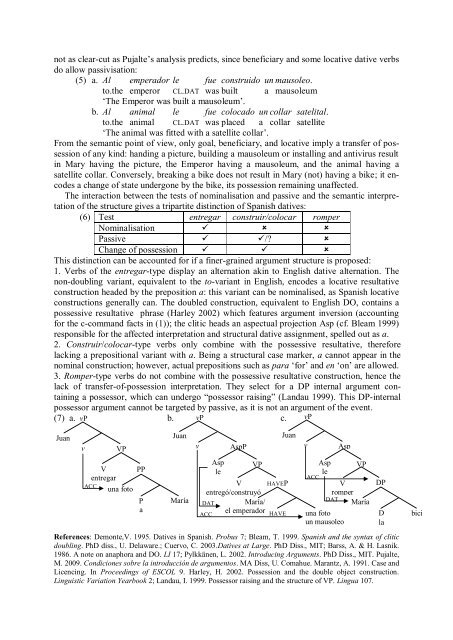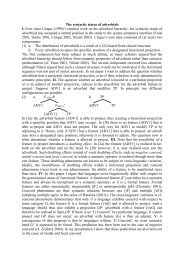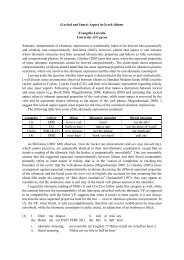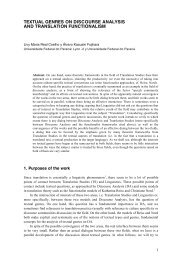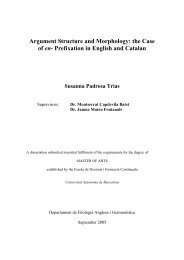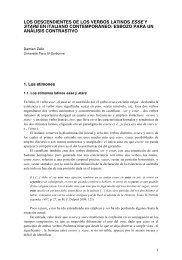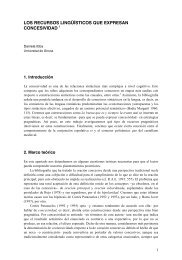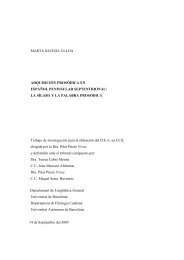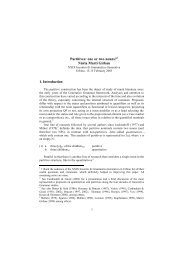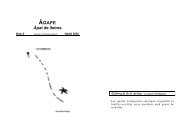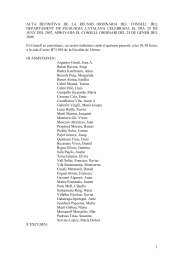Datives, prepositions, and argument structure in Spanish Héctor ...
Datives, prepositions, and argument structure in Spanish Héctor ...
Datives, prepositions, and argument structure in Spanish Héctor ...
You also want an ePaper? Increase the reach of your titles
YUMPU automatically turns print PDFs into web optimized ePapers that Google loves.
not as clear-cut as Pujalte‟s analysis predicts, s<strong>in</strong>ce beneficiary <strong>and</strong> some locative dative verbs<br />
do allow passivisation:<br />
(5) a. Al emperador le fue construido un mausoleo.<br />
to.the emperor CL.DAT was built a mausoleum<br />
„The Emperor was built a mausoleum‟.<br />
b. Al animal le fue colocado un collar satelital.<br />
to.the animal CL.DAT was placed a collar satellite<br />
„The animal was fitted with a satellite collar‟.<br />
From the semantic po<strong>in</strong>t of view, only goal, beneficiary, <strong>and</strong> locative imply a transfer of possession<br />
of any k<strong>in</strong>d: h<strong>and</strong><strong>in</strong>g a picture, build<strong>in</strong>g a mausoleum or <strong>in</strong>stall<strong>in</strong>g <strong>and</strong> antivirus result<br />
<strong>in</strong> Mary hav<strong>in</strong>g the picture, the Emperor hav<strong>in</strong>g a mausoleum, <strong>and</strong> the animal hav<strong>in</strong>g a<br />
satellite collar. Conversely, break<strong>in</strong>g a bike does not result <strong>in</strong> Mary (not) hav<strong>in</strong>g a bike; it encodes<br />
a change of state undergone by the bike, its possession rema<strong>in</strong><strong>in</strong>g unaffected.<br />
The <strong>in</strong>teraction between the tests of nom<strong>in</strong>alisation <strong>and</strong> passive <strong>and</strong> the semantic <strong>in</strong>terpretation<br />
of the <strong>structure</strong> gives a tripartite dist<strong>in</strong>ction of <strong>Spanish</strong> datives:<br />
(6) Test entregar construir/colocar romper<br />
Nom<strong>in</strong>alisation <br />
Passive /? <br />
Change of possession <br />
This dist<strong>in</strong>ction can be accounted for if a f<strong>in</strong>er-gra<strong>in</strong>ed <strong>argument</strong> <strong>structure</strong> is proposed:<br />
1. Verbs of the entregar-type display an alternation ak<strong>in</strong> to English dative alternation. The<br />
non-doubl<strong>in</strong>g variant, equivalent to the to-variant <strong>in</strong> English, encodes a locative resultative<br />
construction headed by the preposition a: this variant can be nom<strong>in</strong>alised, as <strong>Spanish</strong> locative<br />
constructions generally can. The doubled construction, equivalent to English DO, conta<strong>in</strong>s a<br />
possessive resultative phrase (Harley 2002) which features <strong>argument</strong> <strong>in</strong>version (account<strong>in</strong>g<br />
for the c-comm<strong>and</strong> facts <strong>in</strong> (1)); the clitic heads an aspectual projection Asp (cf. Bleam 1999)<br />
responsible for the affected <strong>in</strong>terpretation <strong>and</strong> structural dative assignment, spelled out as a.<br />
2. Construir/colocar-type verbs only comb<strong>in</strong>e with the possessive resultative, therefore<br />
lack<strong>in</strong>g a prepositional variant with a. Be<strong>in</strong>g a structural case marker, a cannot appear <strong>in</strong> the<br />
nom<strong>in</strong>al construction; however, actual <strong>prepositions</strong> such as para „for‟ <strong>and</strong> en „on‟ are allowed.<br />
3. Romper-type verbs do not comb<strong>in</strong>e with the possessive resultative construction, hence the<br />
lack of transfer-of-possession <strong>in</strong>terpretation. They select for a DP <strong>in</strong>ternal <strong>argument</strong> conta<strong>in</strong><strong>in</strong>g<br />
a possessor, which can undergo “possessor rais<strong>in</strong>g” (L<strong>and</strong>au 1999). This DP-<strong>in</strong>ternal<br />
possessor <strong>argument</strong> cannot be targeted by passive, as it is not an <strong>argument</strong> of the event.<br />
(7) a. vP<br />
b. vP<br />
c. vP<br />
Juan<br />
v<br />
V<br />
entregar<br />
ACC<br />
VP<br />
una foto<br />
PP<br />
P<br />
a<br />
Juan<br />
María<br />
v<br />
Asp<br />
le<br />
References: Demonte,V. 1995. <strong>Datives</strong> <strong>in</strong> <strong>Spanish</strong>. Probus 7; Bleam, T. 1999. <strong>Spanish</strong> <strong>and</strong> the syntax of clitic<br />
doubl<strong>in</strong>g. PhD diss., U. Delaware.; Cuervo, C. 2003.<strong>Datives</strong> at Large. PhD Diss., MIT; Barss, A. & H. Lasnik.<br />
1986. A note on anaphora <strong>and</strong> DO. LI 17; Pylkkänen, L. 2002. Introduc<strong>in</strong>g Arguments. PhD Diss., MIT. Pujalte,<br />
M. 2009. Condiciones sobre la <strong>in</strong>troducción de <strong>argument</strong>os. MA Diss, U. Comahue. Marantz, A. 1991. Case <strong>and</strong><br />
Licenc<strong>in</strong>g. In Proceed<strong>in</strong>gs of ESCOL 9. Harley, H. 2002. Possession <strong>and</strong> the double object construction.<br />
L<strong>in</strong>guistic Variation Yearbook 2; L<strong>and</strong>au, I. 1999. Possessor rais<strong>in</strong>g <strong>and</strong> the <strong>structure</strong> of VP. L<strong>in</strong>gua 107.<br />
AspP<br />
VP<br />
V<br />
entregó/construyó<br />
María/<br />
el emperador<br />
DAT<br />
ACC<br />
HAVEP<br />
HAVE<br />
Juan<br />
v Asp<br />
P<br />
Asp<br />
le<br />
ACC<br />
V<br />
VP<br />
romper<br />
DAT María<br />
una foto<br />
un mausoleo<br />
DP<br />
D<br />
la<br />
bici


